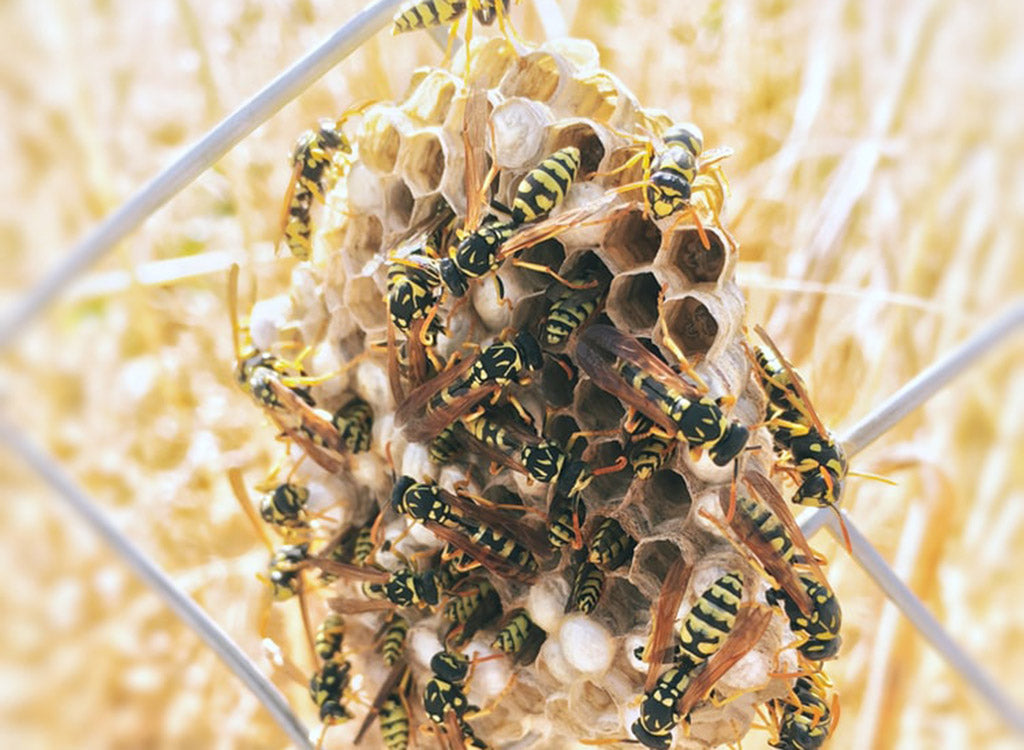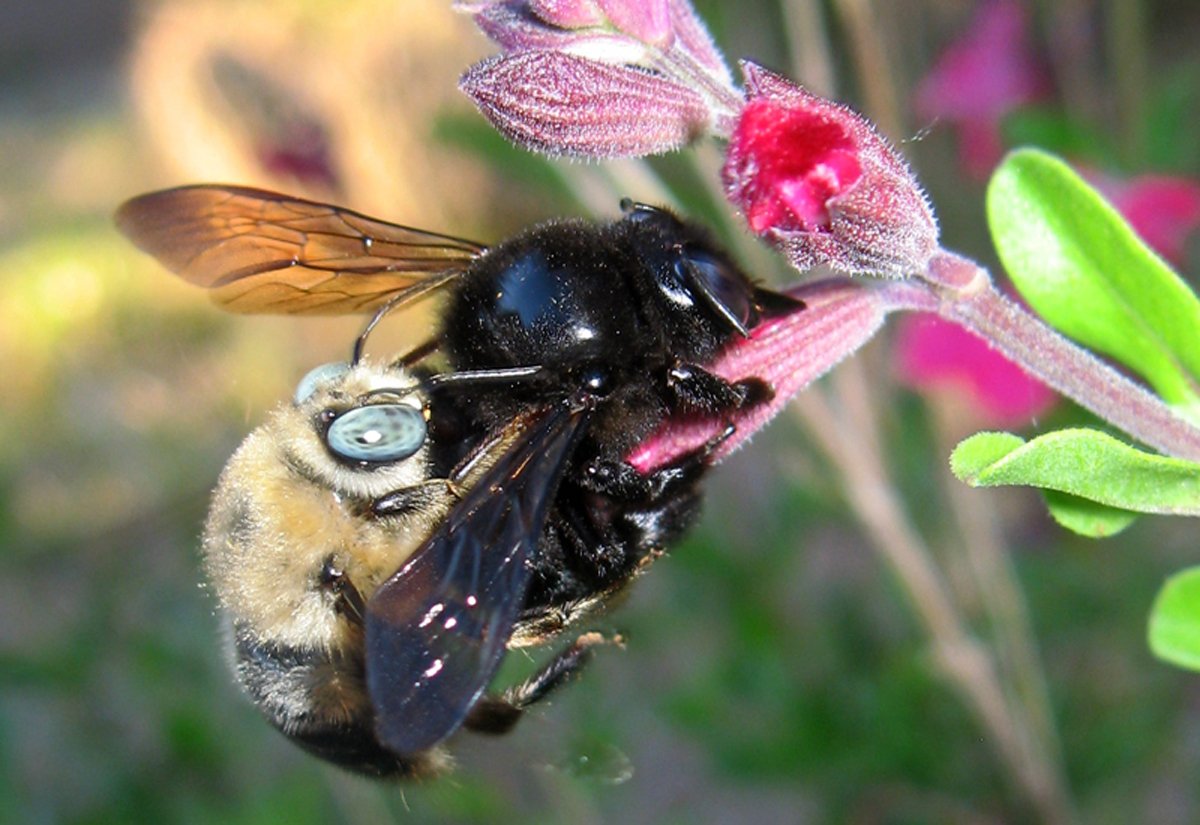Despite their imposing size and capacity for swift, repeated stings, hornets and other wasps are not the top predators in their ecosystem. While these winged defenders of the nest are not to be taken lightly, there are myriad insects and animals that will gladly make a meal out of them given the chance. Let’s take a closer look at the hidden helpers keeping your backyard free of hornets and other wasps.
What Eats Hornets and Other Wasps?
You might be surprised to find that despite the creatures’ fierce reputation, the list of natural predators for wasps is actually quite long. To get things started, let’s talk about the cheery notion of intra-family predation. Among species of the Vespidae family, which includes all the social wasps (yellow jackets, hornets, and paper wasps)1 the bald-faced hornet and their larger, European cousin the European bald-faced hornet (both actually yellow jackets) have no qualms about eating other species of yellow jackets or similarly small wasps.2

Photo Credit: Enrique Vidal Flores
Beyond members of their own family, wasps are prey for a variety of arthropods that will opportunistically feed on them if given the chance. These include dragonflies, praying mantises,3 centipedes, moths and even enterprising parasitoids like the bee fly (though in this case the feeding is limited to wasp eggs and larvae).4
Natural Predators with Feathers
Outside the realm of insects, a variety of birds have also been known to make a meal of a wasp or two. Some natural wasp predators have even become quite adept at dealing with those pesky stingers. The summer tanager, for example, catches wasps in midair and smashes them against tree branches before wiping the stinger off to feast on its now-dead prey. Tanagers are also paper wasp nest robbers who use their beaks to rip into nests and feed on larvae.5

Photo Credit: https://www.usgs.gov/
Another interesting example of biological adaptations in wasp predators is the European honey buzzard. Contrary to its name, the honey buzzard doesn’t eat honey and prefers the larvae of hornets and other wasps, and is the sole known predator of the Asian giant hornet6. In order to combat the obvious danger of multiple stings, the honey buzzard’s facial feathers have adapted and evolved to act as armor, effectively repelling wasp attacks while it roots through a nest, digging for its preferred delicacy: squishy larvae.
The red-throated caracara is also a known predator of wasp larvae.7

Photo Credit: ebird.org
Besides Birds, What Animals Eat Wasps?
Rather than provide an exhaustive list of all the animals in the world that might partake in a crunchy wasp snack, we’ve limited the discussion in this section to mammals specifically. In this case, some of the more common wasp predators are badgers8, bears, racoons, skunks and hedgehogs.
Badgers are well known for their toughness and ferocity in the face of danger, and perhaps this is what makes them so uniquely situated to brave a nest full of wasps. Like others mentioned on the list, the badger is not so much interested in the adult wasps as it is the larvae hidden deep within the nest. Similarly, rats, weasels and skunks have been known to prey upon yellow jacket nests from time to time.9
When it comes to the larger mammals, the unrivaled giant of wasp predators is surely the bear. However, it’s important to note that the stereotype of the hungry bear scooping out mounds of warm honeycomb might not be completely accurate. In fact, while bears have been known to enjoy a sweet dessert, some species – including the grizzly bear – actually prefer the protein-rich nutrients of insect larvae, including those of hornets and other wasps.10
The Takeaway
While there are numerous insects, mammals, birds and other creatures that would gladly take a chomp out of your wasp problem, the truth is that no one class of animal species is an effective deterrent of wasps and hornets near your home. After all, is it really a better situation if you replace a colony of angry hornets with a marauding bear? Probably not.

In order to best protect yourself and your family, we recommend being proactive in your defense. Our Wasp Traps Traps & Deterrents page is a great place to get started to prepare for wasp season, ensuring that you and your loved ones can enjoy the beautiful weather sting-free.
- “Social Wasps,” Agriculture and Life Sciences, NC State University, accessed March 19, 2021, https://genent.cals.ncsu.edu/bug-bytes/social-insects/social-wasps/.
- Michael Waldvogel, Stephen Bambara and Matt Bertone, “European Hornets,” Biting and Stinging Pests, NC State Extension, January 1, 2011, https://content.ces.ncsu.edu/european-hornets.
- Jessica Kaczor, comp., “Bald-Faced Hornet,” Penn State New Kensington, updated August 31, 2014, accessed March 19, 2021, https://www.dept.psu.edu/nkbiology/naturetrail/speciespages/bald_faced_hornet.html.
- “Bee Flies,” Field Guide, Missouri Department of Conservation, https://nature.mdc.mo.gov/discover-nature/field-guide/bee-flies.
- “Summer Tanagers: Wasp Hunters,” BirdNote, February 25, 2021, https://www.birdnote.org/listen/shows/summer-tanagers-wasp-hunters#:~:text=The%20Summer%20Tanager%20snatches%20bees,on%20the%20Summer%20Tanager's%20menu.
- Jessica Law, “Anti-poaching Camps Give Honey-Buzzard Sweet Taste of Success,” BirdLife, April 8, 2019, https://www.birdlife.org/europe-and-central-asia/news/anti-poaching-camps-give-honey-buzzard-sweet-taste-success.
- “Red-Throated Caracara,” eBird, accessed March 19, 2021, https://ebird.org/species/retcar2.
- Caitlynn Lowe, “Things That Eat Wasps & Bees,” Sciencing, March 2, 2019, https://sciencing.com/things-eat-wasps-bees-8051549.html.
- E. C. Mussen, “Yellowjackets and Other Social Wasps,” University of California Agriculture and Natural Resources, updated March 2012, http://ipm.ucanr.edu/PMG/PESTNOTES/pn7450.html.
- David J. Mattson, “Consumption of Wasps and Bees by Yellowstone Grizzly Bears,” Northwest Science 76 no. 2 (2002): 166–72, https://research.libraries.wsu.edu/xmlui/handle/2376/951.









Leave a comment
All comments are moderated before being published.
This site is protected by hCaptcha and the hCaptcha Privacy Policy and Terms of Service apply.